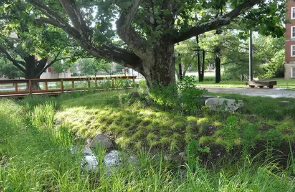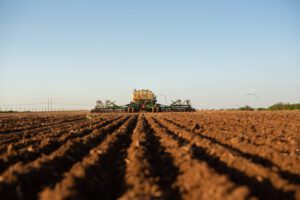Homeowners looking to enhance their landscape this year while managing stormwater have options available. Green infrastructure options include permeable pavement, rain barrels, large trees, green roofs, raingardens, bioswales, and more. Each of these systems are designed to utilize technologies or replicate natural systems in urban areas that create habitat, reduce the heat island effect, improve air quality, enhance the visual appeal of communities, and/or manage stormwater.
Raingardens and bioswales are two powerful, accessible solutions for homeowners. Both help control runoff, reduce erosion, and create critical wildlife habitat, yet they differ in design and function. Understanding the differences is key to choosing the right option and implementation to achieve maximum results.
Rain gardens
Rain gardens are shallow, depressed areas in the landscape, designed to capture stormwater runoff from adjacent land and structures. Stormwater is allowed to filter through the soil of these planting areas. Rain gardens can be designed and installed as attractive landscape beds, often planted with a mix of blooming plants that are well-adapted to enhance the water infiltration task of a rain garden.
Despite having a final look that resembles a traditional landscape bed, rain garden design takes into account the infiltration rate of the soil and is built to a size that is capable of accommodating a specific amount of run off from the surrounding landscape.
It is recommended that rain garden placement is, at minimum, ten feet away from the foundation of an adjacent building with a slope of 1:12 percent away from the structure to insure adequate drainage. Down spouts, reinforced swales, or a subdrain can be used to feed water directly into a rain garden.
During heavy rainfall events, rain gardens may reach capacity. To prevent damage, rain gardens need to be designed with an overflow outlet. An overflow pipe or a relief in the sidewall of the rain garden can serve this purpose. The height of the overflow is based on the depth of the rain garden, it is lower than the top edge of the garden but high enough to allow the garden to retain a calculated amount of water for infiltration.
Bioswales
Bioswales differ from rain gardens in form and scale. Designed to capture and convey stormwater, bioswales are sloped channels that infiltrate water while water flows away from the source site. Typically, bioswales are capable of managing larger volumes of storm water and are engineered to include a subgrade of amended soils.
Where the commonalities lie
The objective of each garden is to capture stormwater and allow it to infiltrate into the soil. By creating a space for stormwater runoff to slowly soak into the soil profile rather than quickly run over land, entering open water systems or storm sewers. Benefits of stormwater infiltration include pollutants and contaminants are removed, groundwater is recharged, water is cooled before entering local stream corridors enhancing aquatic habitats, and it reduces strain on local stormwater sewer systems.
Functioning raingardens and bioswales utilize similar plant palettes. Native species are recommended for many reasons, particularly their robust, deep reaching root systems. As native plants become established in a raingarden or bioswale, their roots penetrate deep into the soil profile creating pore space that improves water infiltration capacity. Additionally, they help protect soil from erosion, are capable of withstanding dry periods, and are tolerant of more challenging soil profiles.
Choosing which native plants to include in a planting is based on sun exposure, soil type, garden size, and personal aesthetic preferences. Depending on the size of the garden, trees, shrubs, perennial grasses and perennial flowers are options. Placement requires special consideration due to the slope of the gardens. Similar to traditional gardens, pay attention to the size of the plant and place it in the garden so a layered look is achieved. Also note the moisture preferences of the species, use this information to locate the plants in the base of the garden where conditions will be moist, the top of the slope where soil conditions will be dryer, or the middle of the slope where soil moisture will be moderate as compared to the top and bottom of the garden.
What about mosquitoes?
Rain gardens and bioswales, if designed and constructed properly, will not hold water for the length of time necessary for mosquitos to reproduce. Mosquitos require one to two days of standing water for eggs to hatch. Another seven to ten days is required for the larvae to develop into adults. Rain gardens and bioswales aim to infiltrate water within 24 hours.
Good Growing Fact of the Week: The Red Oak Rain Garden, located on the University of Illinois at Urbana-Champaign campus, contains more than 50 species of native plants and is capable of absorbing over 27,000 gallons of stormwater. The site is open to the public and is located between Allen Hall and McKinley Health Center.
***Courtesy of the University of Illinois Extension***














